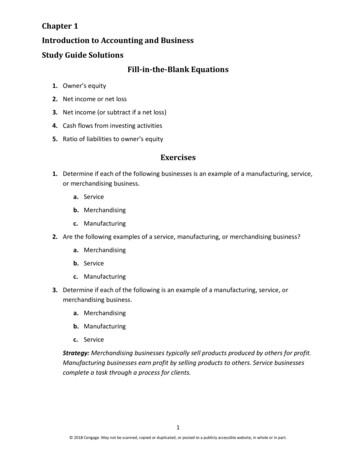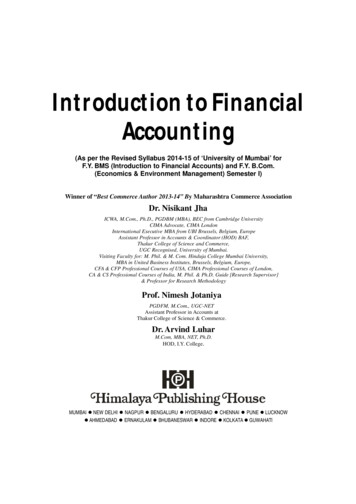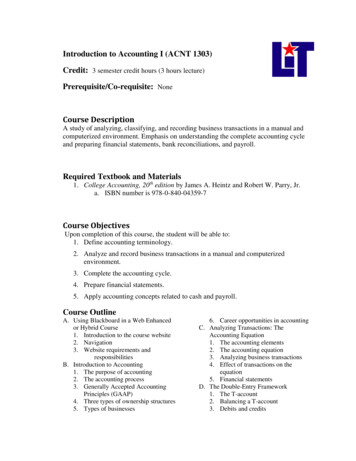
Transcription
Chapter 1Introduction to Accounting and BusinessStudy Guide SolutionsFill-in-the-Blank Equations1. Owner’s equity2. Net income or net loss3. Net income (or subtract if a net loss)4. Cash flows from investing activities5. Ratio of liabilities to owner’s equityExercises1. Determine if each of the following businesses is an example of a manufacturing, service,or merchandising business.a. Serviceb. Merchandisingc. Manufacturing2. Are the following examples of a service, manufacturing, or merchandising business?a. Merchandisingb. Servicec. Manufacturing3. Determine if each of the following is an example of a manufacturing, service, ormerchandising business.a. Merchandisingb. Manufacturingc. ServiceStrategy: Merchandising businesses typically sell products produced by others for profit.Manufacturing businesses earn profit by selling products to others. Service businessescomplete a task through a process for clients.1 2018 Cengage. May not be scanned, copied or duplicated, or posted to a publicly accessible website, in whole or in part.
2Chapter 14. Are the following examples of managerial or financial accounting?a. Financial accountingb. Managerial accountingc. Financial accounting5. Are the following stakeholders internal or external users in a company? Would each usemanagerial or financial accounting?a. External; financial accountingb. Internal; managerial accountingc. External; financial accounting6. Would each of the following be an example of managerial or financial accounting?a. Financialb. Managerialc. ManagerialStrategy: Managerial accounting is used by internal users of the company, such asmanagers. External users utilize financial accounting to base decisions on the financialinformation given.7. Determine if each of the following is a characteristic of a proprietorship, partnership,corporation, or limited liability company.a. Corporationb. Proprietorshipc. Limited liability companyd. Partnership8. Determine the type of business entity from the following independent characteristics.a. Proprietorshipb. Corporationc. Partnershipd. Limited liability company 2018 Cengage. May not be scanned, copied or duplicated, or posted to a publicly accessible website, in whole or in part.
Introduction to Accounting and Business39. Do the following separate qualities describe a proprietorship, partnership, corporation,or limited liability company?a. Limited liability companyb. Corporationc. Proprietorshipd. PartnershipStrategy: A sole proprietorship has only one owner, who has full liability for thecompany. A partnership has two or more partners, who combine resources for profit andusually have liability. A corporation acts as a separate entity, meaning it pays its owntaxes and is liable for itself. A limited liability company gives owners limited liability butstill has partnership taxation.10. Determine the accounting concept that relates to each of the following descriptions.a. Business entity conceptb. Cost conceptc. Objectivity concept11. Which accounting concept do the following characteristics define?a. Unit of measure conceptb. Matching conceptc. Business entity concept12. Which accounting concept relates to the following examples?a. Cost conceptb. Objectivity conceptc. Matching conceptStrategy: Using the basic accounting concepts ensures that the financial statements arefair and accurate.13. If a business has the following balances, how much is total liabilities? 18,975; 21,575 18,975 2,600 2018 Cengage. May not be scanned, copied or duplicated, or posted to a publicly accessible website, in whole or in part.
4Chapter 114. During the first year, Fox Supply has total assets of 15,000 and liabilities of 10,875.During the second year, assets increase by 1,375, and owner’s equity increases by 950. How much is total liabilities at year-end?Liabilities for the second year equaled 11,300 ( 16,375 – 5,075).During the first year, the account balances show:Assets 15,000 LiabilitiesOwner’s Equity 10,875 4,125After the second year of operations, the account balances show:Assets 16,375 LiabilitiesOwner’s Equity 11,300 5,07515. Shell Company’s Year 5 balance sheet had the following balances: owner’s equity of 4,600 and liabilities of 3,800. During the next year, assets increased by 300, andliabilities decreased by 150. What was the change in owner’s equity?The change in owner’s equity is 450 ( 5,050 – 4,600).After Year 5, the balances show:Assets 8,400 LiabilitiesOwner’s Equity 3,800 4,600At Year 6 year-end, the balances show:Assets 8,700 LiabilitiesOwner’s Equity 3,650 5,050Strategy: Liabilities and owner’s equity combine to equal assets, so begin by solving theunknown amount at the beginning of the period. Next, find the ending amounts byadding or subtracting the changes given. The amounts should still show that assetsequal the sum of liabilities and owner’s equity.16. Determine the dollar effect on the accounting equation (increase or decrease assets,liabilities, or owner’s equity) from the following separate transactions:a. Increase assets and owner’s equity by 4,000b. Increase assets and liabilities by 1,600c. Decrease assets and liabilities by 1,300 2018 Cengage. May not be scanned, copied or duplicated, or posted to a publicly accessible website, in whole or in part.
Introduction to Accounting and Business17. What is the dollar effect on the accounting equation (increase or decrease assets,liabilities, or owner’s equity) from the following independent transactions?a. Decrease assets and owner’s equity by 800b. Increase assets and owner’s equity by 290c. Decrease assets and owner’s equity by 1,40018. Apple Tree had the following balances when formed:AssetsLiabilitiesCashEquipment 2,4001,300Total assets 3,700Notes payable 1,500Owner’s EquityJohnny, capitalTotal liabilities and owner’s equity2,200 3,700During the first year of operations, the following transactions occurred: Collected 12,000 cash in rental revenue. Made a 2,000 investment in equity securities using 1,000 cash and a 1,000note payable. Incurred and paid 2,000 in cash for utilities expense, 3,500 in rent expense,and 2,200 in wages expense. Johnny, Apple Tree’s owner, withdrew 200 in cash from the business andcontributed 1,500 in equipment.Show the cumulative effect on the accounting equation from the transactions for theyear.AssetsCashEquipment2,400 Investments1,300LiabilitiesNotesPayable1,500 )(3,500)(2,200)(200)1,5005,500Owner's 02,5003,50012,000 2018 Cengage. May not be scanned, copied or duplicated, or posted to a publicly accessible website, in whole or in part.5
6Chapter 1Strategy: First, determine which accounts the transaction affects and if the account is anasset, liability, or owner’s equity account. Owner’s equity contains net income, whichmeans revenues and expenses transactions will be included. Next, determine if theamount will increase or decrease the account. The accounting equation should stillbalance after showing the increases and/or decreases.19. Determine to which financial statement the following descriptions relate.a. Balance sheetb. Statement of cash flowsc. Income statementd. Statement of owner’s equity20. Which financial statement is associated with each of the descriptions below?a. Statement of cash flowsb. Balance sheetc. Income statementd. Statement of owner’s equity21. Which financial statement is associated with each of the descriptions below? Also, putthe financial statements in order as they should be prepared.a. Statement of cash flows (4th)b. Balance sheet (3rd)c. Statement of owner’s equity (2nd)d. Income statement (1st)Strategy: To prepare financial statements in the correct order, it is important to knowwhich amounts flow to the next financial statement to be prepared. The incomestatement will show net income or loss from the revenues and expenses. The statementof owner’s equity details the changes in an owner’s investment in the company. Becausethe owner’s investment produces the income, net income should be included. The yearend owner’s equity flows to the balance sheet. The statement of cash flows includes cashand all other activities to arrive at the year-end cash balance and to match the balancesheet. 2018 Cengage. May not be scanned, copied or duplicated, or posted to a publicly accessible website, in whole or in part.
Introduction to Accounting and Business722. Given the following transactions for the year, prepare the income statement for WorldCo. for the year ended December 31, 20Y5. Rental revenue of 15,000 Wages expense of 3,500 Rental expense of 5,300 Miscellaneous expense of 1,200World Co.Income StatementFor the Year Ended December 31, 20Y5Rental revenue 15,000Expenses:Rental expense 5,300Wages expense3,500Miscellaneous expense1,200Total expenses10,000Net income 5,00023. Create World Co.’s statement of owner’s equity using net income from Exercise 22. Atthe beginning of the year, John Green’s owner capital account had a balance of 12,000,with the following changes during the year: Additional cash contributions of 1,500 Cash withdrawals of 2,100World Co.Statement of Owner's EquityFor the Year Ended December 31, 20Y5John Green, capital, January 1, 20Y5Contributions 1,500Net income for the year5,000Withdrawals(2,100)Increase in owner's equityJohn Green, capital, December 31, 20Y5 12,0004,400 16,400 2018 Cengage. May not be scanned, copied or duplicated, or posted to a publicly accessible website, in whole or in part.
8Chapter 124. Using the information from Exercise 23, prepare World Co.’s balance sheet if thecompany had the following balances: Accounts payable: 2,300 Inventory: 5,000 Accounts receivable: 1,400 Cash: 1,500 Property, plant, and equipment: 12,000 Notes payable: 1,200World Co.Balance SheetDecember 31, 20Y5AssetsCashAccounts receivableInventoryPP&ETotal assetsLiabilities 1,5001,4005,00012,000 19,900Accounts payableNotes payable 2,3001,200Owner's EquityJohn Green, capitalTotal liabilities and owner's equity16,400 19,90025. Prepare World Co.’s statement of cash flows using the year-end amount from Exercise24. During the first year of operations, the following activities occurred: Cash revenue of 13,600 Cash contribution from owner of 1,500 Cash payments for expenses of 10,000 Cash received from notes payable of 1,800 Purchase of new equipment for 3,300 Cash withdrawals by owner of 2,100 2018 Cengage. May not be scanned, copied or duplicated, or posted to a publicly accessible website, in whole or in part.
Introduction to Accounting and BusinessWorld Co.Statement of Cash FlowsFor the Year Ended December 31, 20Y5Cash flows from operating activities:Cash received from customers 13,600Cash payments for expenses(10,000)Net cash flow from operating activitiesCash flows from investing activities:Cash payments for equipmentCash flows from financing activities:Cash received from owner as investment 1,500Cash received from notes payable1,800Cash withdrawals by owner(2,100)Net cash flow from financing activitiesNet increase in cash during yearCash as of January 1, 20Y5Cash as of December 31, 20Y5 3,600(3,300)1,200 1,5000 1,50026. If the following transactions occurred for the year June 30, 20Y5, what is Purple Sun’snet income or net loss? Find the amount using an income statement. Earned fees of 21,700 Utilities expense of 2,300 Miscellaneous expense of 4,300 Interest expense of 1,200 Wages expense of 4,200Purple SunIncome StatementFor the Year Ended June 30, 20Y5Fees earnedExpenses:Wages expenseUtilities expenseInterest expenseMiscellaneous expenseTotal expensesNet income 21,700 4,2002,3001,2004,30012,000 9,700 2018 Cengage. May not be scanned, copied or duplicated, or posted to a publicly accessible website, in whole or in part.9
10Chapter 127. Using the net income found in Exercise 26 and the information below, create PurpleSun’s statement of owner’s equity. The total owner’s equity at the beginning of the yearequaled 16,700. Fred D. (owner) contributed cash of 2,300. Fred D. made a 6,200 withdrawal.Purple SunStatement of Owner's EquityFor the Year Ended June 30, 20Y5Fred D., capital, July 1, 20Y4Contributions 2,300Net income for the year9,700Withdrawals(6,200)Increase in owner’s equityFred D., capital, June 30, 20Y5 16,7005,800 22,50028. Create Purple Sun’s balance sheet using the amounts found in Exercise 27 and thefollowing account balances: Property, plant, and equipment: 18,800 Cash: 6,200 Accounts payable: 4,000 Investments in securities: 1,500Purple SunBalance SheetJune 30, 20Y5AssetsCashInvestments in securitiesPP&ETotal assetsLiabilities 6,200 Accounts payable1,500Owner’s Equity18,800 Fred D., capital 26,500 Total liabilities and owner’s equity 4,00022,500 26,500 2018 Cengage. May not be scanned, copied or duplicated, or posted to a publicly accessible website, in whole or in part.
Introduction to Accounting and Business29. At the beginning of the year, Purple Sun had a cash balance of 3,100. Prepare thestatement of cash flows given the following information and the ending cash balancefrom Exercise 28. Purchased land for 12,000; 6,000 cash and issued 6,000 long-term notepayable to the seller Cash received from customers, 20,000 Cash received from owner, 2,300 Cash withdrawal made by owner, 6,200 Cash payments for expenses, 7,000Purple SunStatement of Cash FlowsFor the Year Ended June 30, 20Y5Cash flows from operating activities:Cash received from customersCash payments for expensesNet cash flow from operating activitiesCash flows from investing activities:Cash payments for landCash flows from financing activities:Cash received from owner as investmentCash withdrawal by ownerNet cash flow from financing activitiesNet increase in cash during yearCash as of July 1, 20Y4Cash as of June 30, 20Y5 20,000(7,000) 13,000(6,000) 2,300(6,200)(3,900) 3,1003,100 6,20030. With the following transactions, create Polka Dot’s income statement for the yearended September 30, 20Y5. Interest revenue of 23,000 Interest expense of 14,000 Rent expense of 4,000 Legal expense of 1,400 Wages expense of 3,200 Miscellaneous expense of 2,200 2018 Cengage. May not be scanned, copied or duplicated, or posted to a publicly accessible website, in whole or in part.11
12Chapter 1Polka DotIncome StatementFor the Year Ended September 30, 20Y5Interest revenue 23,000Expenses:Interest expense 14,000Rent expense4,000Wages expense3,200Legal expense1,400Miscellaneous expense2,200Total expenses24,800Net loss (1,800)Strategy: The title should include the name of the company, the title of the financialstatement (Income Statement), and the period of time that the financial statementcovers (for the year ended, for the period ended). First, begin with revenue. Expensescome after the revenue to show that the expenses were incurred during the same time toproduce the revenue. Subtract the total expenses from total revenue to find the netprofit (positive amount) or net loss (negative amount).31. Polka Dot’s owner, Ellen Pink, had beginning capital in the company of 3,000 for theyear. During the year, she made a withdrawal of 1,000. Prepare the statement ofowner’s equity for the year using the net income and information from Exercise 30.Polka DotStatement of Owner's EquityFor the Year Ended September 30, 20Y5Ellen Pink, capital, October 1, 20Y4Net loss (1,800)Withdrawal(1,000)Decrease in owner's equityEllen Pink, capital, September 30, 20Y5 3,000(2,800) 200Strategy: The title should include the name of the company, the title of the financialstatement (Statement of Owner’s Equity), and the period of time that the financialstatement covers (for the year ended, for the period ended). First, begin with the capitalinvestment at the beginning of the year. Next, find the net increase or decrease for theyear from the activity for the year. The net increase or decrease is added to thebeginning capital amount to calculate the ending balance. 2018 Cengage. May not be scanned, copied or duplicated, or posted to a publicly accessible website, in whole or in part.
Introduction to Accounting and Business1332. Using the ending capital balance from Exercise 31, create Polka Dot’s balance sheet. Thecompany had the following ending account balances: Cash: 1,900 Investment in securities: 22,000 Notes payable: 20,000 Property, plant, and equipment: 5,000 Interest payable: 4,200 Accounts payable: 4,500Polka DotBalance SheetSeptember 30, 20Y5AssetsCashInvestments in securitiesPP&ETotal assetsLiabilities 1,900 Accounts payable22,000 Interest payable5,000 Notes payableOwner's EquityEllen Pink, capital 28,900 Total liabilities and owner's equity 4,5004,20020,000200 28,900Strategy: The title should include the name of the company, the title of the financialstatement (Balance Sheet), and the date that the account balances are measured. Thebalance sheet shows amounts as of a certain date. First, find the sum of the total assets.Next, calculate total liabilities. Last, add the total owner’s equity, carrying over thecapital measured for the year-end from the statement of owner’s equity.33. At the beginning of the year, Polka Dot’s bank statement showed a balance of 5,200for cash. With the transactions below, reconcile the beginning to ending amount fromExercise 32 using a statement of cash flows. Cash received from interest, 20,000 Cash paid for interest, 12,000 Cash paid for expenses, 17,300 Withdrawal by owner, 1,000 Cash paid for new building, 5,000 Cash received from customers, 12,000 2018 Cengage. May not be scanned, copied or duplicated, or posted to a publicly accessible website, in whole or in part.
14Chapter 1Polka DotStatement of Cash FlowsFor the Year Ended September 30, 20Y5Cash flows from operating activities:Cash received from customers 12,000Cash payments for expenses(17,300)Net cash flow from operating activitiesCash flows from investing activities:Purchase of buildingCash flows from financing activities:Interest received 20,000Interest paid(12,000)Withdrawal by owner(1,000)Net cash flow from financing activitiesNet decrease in cash during yearCash as of October 1, 20Y4Cash as of September 30, 20Y5 (5,300)(5,000)7,000 (3,300)5,200 1,900Strategy: The title should include the name of the company, the title of the financialstatement (Statement of Cash Flows), and the period of time that the financialstatement covers (for the year ended, for the period ended). The first section should beCash flows from operating activities, which are the main operations of the business. Thesecond section is Cash flows from investing activities, which includes activities for longterm investments. The last section is Cash flows from financing activities, which includesactivities used to finance the operations of the company.34. Given the following company’s balances for liabilities and owner’s equity, calculate theratio of liabilities to owner’s equity. Round answers to two decimal places. Indicate thecompany with the lowest credit risk for creditors and the company with the highest risk.CompanyWorld Co.Purple SunPolka DotLiabilities 3,5004,00028,700Owner’s Equity 16,40022,500200Ratio0.210.18143.50Purple Sun’s creditors have the lowest risk, while Polka Dot’s creditors have the highestrisk. 2018 Cengage. May not be scanned, copied or duplicated, or posted to a publicly accessible website, in whole or in part.
Introduction to Accounting and Business1535. Blue Company’s account balances for liabilities and owner’s equity for the past twoyears are shown below. Calculate the ratio of liabilities to owner’s equity, rounding totwo decimal places. Then, indicate if the company’s creditors are more or less at risk.LiabilitiesOwner’s equityRatio12/31/20Y6 12/31/20Y5 15,000 14,750 14,800 14,0001.011.05Because the ratio decreased from 20Y5 to 20Y6, the company’s creditors are less at risk.The company’s creditors are more likely to receive their investment after paying theliabilities.36. Calculate the ratio of liabilities to owner’s equity with the information given for BroomCo., rounding to two decimal places. Then, indicate if the company’s creditors are moreor less at risk than the previous year.LiabilitiesOwner’s equityRatio12/31/20Y6 12/31/20Y5 90,250 87,000 60,000 67,0001.501.30Because the company’s ratio of liabilities to owner’s equity increased, the company’screditors are more at risk. The creditors are less likely to receive the amount theyinvested after repayment of the company’s liabilities.Strategy: The ratio of liabilities to owner’s equity indicates the amount of risk creditorsmay have to receive the amount of their investment. The higher the ratio, the less likelythe owners will receive their repayment. The company will have more liabilities to repaybefore paying the owner investments because the owners are paid last. 2018 Cengage. May not be scanned, copied or duplicated, or posted to a publicly accessible website, in whole or in part.
Which accounting concept relates to the following examples? a. Cost concept. b. Objectivity concept . c. Matching concept . Strategy: Using the basic accounting concepts ensures that the financial statements are fair and accurate. 13. If a business has the following balances, how much is total liabilities? 18,975; 21,575 18,975 2,600











